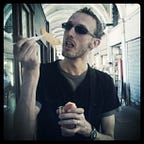31st October 2018 | 31 Days of “Alternative” Horror: Don’t Look Now
There are few movies that I can say have given so much, and it seems that no matter how many times I watch this classic, I’m being transported there as if it were for the first time. Now, I think much like Invasion of the Body Snatchers, this movie is well known but rarely watched because of reasons that probably cannot be reasoned with. Don’t Look Now would usually pass through your eyes if you were a student of film, or a connoisseur of the genre. There are a few who watch it because they recognise Venice from the picture. I’m sure if you’ve been to Venice, it has never looked quite like this. To see Venice according to Nicolas Roeg, you have to be there in the dead of winter. Venice here is playing a character that has everybody in a game, or a bubble, providing refuge or leading characters down the wrong path. Venice makes creative choices about its intention in the scene, and evolves by acting and reacting to the situation as it plays out, adapting with its many costume changes and makeup arrangements that either help or hinder.
So for the uninitiated: Don’t Look Now is a story of the mind, about a couple John, played by Donald Sutherland, and Laura, played by Julie Christie. Their daughter, Christine, played by Sharon Williams, drowns while playing near a river, at the bottom of their country home.
Their lives are never the same, but while dealing with their grief, John the architect decides to bring Laura along with him to Venice for his latest restoration: mosaic detail work in churches in Venice. It’s a change of scene. A break from familiarity. Upon arriving in Venice, John starts seeing a certain little somebody wearing a red coat: the image being that of his daughter, the way he found her, but here it is distant, peripheral. He however dismisses the visions and doesn’t want anything to do with exploring them further. Well, not yet anyway. Elsewhere, Laura is told by two English-speaking ladies that her daughter is trying to communicate with her from the other side. Laura becomes fixated, and urges her not to believe such “rubbish”. John’s work is a good distraction. When together, Laura and John seem distant, and as it seems, this trip to Venice is much about saving a marriage — or at times, letting it fall further apart in unfamiliar surroundings.
Moments in Venice take on a whole new meaning, with ghostly apparitions, a killer on the loose and something to either John or Laura, but not at the same time. They only appear on the same page when they are alone, intimate, but even those moments are fractured, showing separation, and distant thoughts while each of them dress. I sometimes wonder if the intercut love scene was real or just wishful imaginings on Laura’s part. It could be that they were never on the same page, or even the same time. Laura seems stuck in the past, whereas John fights to remain present, but in isolated moments, projects himself into the future. The only time where the two lines of life converge is when they share feelings about their daughter, Christine, who remains as the only thing that binds them.
There is so much to talk about this film: the pain and the performance, the visual and technicality of editing brilliance. The music, the sound design as it dips from silences to crashing, all of it! Let’s not dismiss the overt comedy, which causes a struggle with the audience sense of appropriateness. Laughter should be contagious, but we have no incentive to join in. This movie is masterful, and it holds a honoured place in my top movies of all time.
Written by: Stephen Radford
website: stephenradford.com
